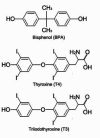Hyperthyroidism in cats: what's causing this epidemic of thyroid disease and can we prevent it?
- PMID: 23087006
- PMCID: PMC11112171
- DOI: 10.1177/1098612X12464462
Hyperthyroidism in cats: what's causing this epidemic of thyroid disease and can we prevent it?
Abstract
Practical relevance: Since first being reported in the late 1970s, there has been a dramatic increase in the prevalence of hyperthyroidism in cats. It is now recognized worldwide as the most common feline endocrine disorder.
Patient group: Hyperthyroidism is an important cause of morbidity in cats older than 10 years of age. It is estimated that over 10% of all senior cats will develop the disorder.
Clinical challenges: Despite its frequency, the underlying cause(s) of this common disease is/are not known, and no one has suggested a means to prevent the disorder. Because of the multiple risk factors that have been described for feline hyperthyroidism, it is likely that more than one factor is involved in its pathogenesis. Continuous, lifelong exposure to environmental thyroid disruptor chemicals or goitrogens in food or water, acting together in an additive or synergistic manner, may first lead to euthyroid goiter and then to autonomous adenomatous hyperplasia, thyroid adenoma and hyperthyroidism.
Evidence base: This review draws on published research studies to summarize the available evidence about the risk factors for feline hyperthyroidism. Based on the known goitrogens that may be present in the cat's food, drinking water or environment, it proposes measures that cat owners can implement that might prevent, or reduce the prevalence of, thyroid tumors and hyperthyroidism in their cats.
Conflict of interest statement
The author does not have any potential conflicts of interest to declare.
Figures







References
-
- Peterson ME, Kintzer PP, Cavanagh PG, Fox PR, Ferguson DC, Johnson GF, et al.. Feline hyperthyroidism: pretreatment clinical and laboratory evaluation of 131 cases. J Am Vet Med Assoc 1981; 183: 103–110. - PubMed
-
- Hoenig M, Goldschmidt MH, Ferguson DC, Koch K, Eymontt MJ. Toxic nodular goitre in the cat. J Small Anim Pract 1982; 23: 1–12. - PubMed
-
- Peterson ME, Ward CR. Etiopathologic findings of hyperthyroidism in cats. Vet Clin North Am Small Anim Pract 2007; 37: 633–645. - PubMed
-
- Mooney CT, Peterson ME. Feline hyperthyroidism. In: Mooney CT, Peterson ME. (eds). Manual of canine and feline endocrinology. 4th ed. Quedgeley, Gloucester: British Small Animal Veterinary Association, 2012, pp 92–110.
-
- Baral R, Peterson ME. Thyroid gland disorders. In: Little SE. (ed). The cat: clinical medicine and management. Philadelphia: Elsevier Saunders, 2012, pp 571–592.
Publication types
MeSH terms
LinkOut - more resources
Full Text Sources
Medical
Miscellaneous

